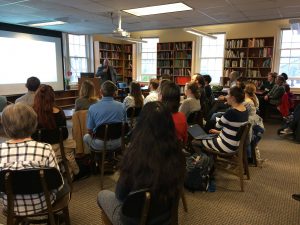CSCRS strategically connects students and professionals with Safe Systems principles
The Collaborative Science Center for Road Safety’s mission is to “create and exchange knowledge to advance transportation safety through a multidisciplinary, Safe Systems approach.” To support this mission, CSCRS has defined two specific goals to see that:
- a growing body of students and future leaders are engaged and well-trained in road safety principles and Safe Systems approaches and methods; and
- Safe Systems principles and approaches are shared, understood, and adopted by traffic safety professionals (traditional and nontraditional) and stakeholders.
All CSCRS consortium universities – Duke University, Florida Atlantic University, University of California-Berkeley, University of North Carolina-Chapel Hill, and University of Tennessee-Knoxville – have launched learning and training programs by leveraging existing networks and resources. Many of CSCRS’s current programs include both education and professional development elements. The following provides a sampling of CSCRS activities underway; for more details, see the education and professional development pages on the CSCRS website.
Engaging students inside and outside the classroom
CSCRS students across all five consortium member universities have gotten involved in the Center’s work through a variety of forms including symposia, lecture series, independent studies, scholarships and fellowships, research assistantships, conference travel and more. For example, students at all campuses are engaging in CSCRS-related research projects covering an array of transportation safety topics, such as maximizing pre-crash kinetic energy dissipation and synthesizing Safe Systems resources.
A highlight of CSCRS’s first year was the Duke University Robotics Student Symposium, an interactive, hands-on event held in April 2017. This event provided an opportunity for about 50 robotics students (ranging from high school to graduate level) from a variety of backgrounds to showcase their work, learn from Duke graduate students and faculty, and network with regional peers. View videos from this unique student opportunity.
Other illustrations of CSCRS student engagement:
- UNC created a scholarship program aimed at cultivating future leaders in transportation safety and injury prevention. In addition to financial support, CSCRS Scholars receive mentorship and academic support from a team of experienced transportation and public health researchers, and are encouraged to engage in student-led or CSCRS-related activities.
- UTK students Mohsen Kamrani and Behram Wali (along with CSCRS Associate Director Asad Khattak) received the 2017 Best Paper Award at the 2018 Transportation Research Board Annual Meeting for “Can Data Generated by Connected Vehicles Enhance Safety? A Proactive Approach to Intersection Safety Management.”
CSCRS also supports many courses designed to engage students on transportation safety topics. Examples of CSCRS fall 2017 and spring 2018 courses include:
- UCB graduate course: Injury Prevention and Control (CSCRS instructor: David Ragland)
- UCB graduate course: Traffic Safety and Injury Control (CSCRS instructors: Offer Grembek, David Ragland)
- Duke combined undergraduate/graduate course: Governance and Adaptive Regulation of Transformational Technologies in Transportation (CSCRS instructor: Michael Clamann)
- UNC combined undergraduate/graduate course: Complete, Safe, Equitable Streets (CSCRS instructor: Tabitha Combs)
In addition, CSCRS was proud to select Dr. Becky Naumann as its first Outstanding Student of the Year.
Reaching out to traffic safety professionals
CSCRS consortium campuses have implemented Safe Systems-focused lecture series geared toward professionals and practitioners in the field:
- FAU launched a Safe Streets Lecture series in March 2018 with a talk by Peter Norton, Professor of History at the University of Virginia, on “The Invention of the Motor Age Street.”

Richard Burgess, Research Associate, Texas Tech, gives an intro to systems thinking and engineering at the first UNC Coffee and Conversation event.
- UNC’s Coffee and Conversation, a 10-part Safe Systems-focused lecture series started in January 2018, is a biweekly dialogue featuring experts in public health, transportation, planning, engineering, and ethics who explore the many interrelated components of our complex transportation system.
- UCB’s Weekly Transportation Safety Seminar series highlights the various research projects being conducted at UCB and beyond. The seminars provide a platform for both researchers and students to share ongoing and completed work, as well as get feedback on a work in progress.
As mentioned, many of CSCRS’s learning activities include both professional development and education, which enhances the opportunity for both audiences. For instance, in January 2018, CSCRS co-hosted the inaugural Safety Sunday @ TRB event in conjunction with the 2018 TRB Annual Meeting. Furthermore, CSCRS researchers make regular appearances presenting at traffic safety-related conferences, many of which feature a sizable student attendance.
Looking ahead
CSCRS is now planning new educational and professional development activities for this year and beyond. In summer 2018, UTK will launch CSI (Crash Scene Investigation) Camp, a unique program designed for high school students. The camp teaches students how to investigate a vehicle crash scene and consider potential contributing factors including environment conditions and vehicle condition. Also, CSCRS will hold the conference Safe Systems Summit: Redefining Transportation Safety in Durham, N.C., September 13-14, 2018.
Please check back at roadsafety.unc.edu for continuing updates on these and more CSCRS activities and events.
Save the date for Safe Systems Summit: Redefining Transportation Safety, Sept. 13-14

Downtown Durham, N.C.
CSCRS will hold the Safe Systems Summit: Redefining Transportation Safety, Sept. 13-14, 2018, in Durham, N.C. This is not your typical transportation conference. The purpose of the Safe Systems Summit is to create a learning environment for a diverse group of cross-sector experts to explore the underlying systems driving the national rise in traffic deaths, share findings from innovative new research, and develop insights into strategies for how to reduce transportation injuries and fatalities by utilizing a multidisciplinary, Safe Systems approach to road safety.
The event will be held at the Durham Convention Center. Registration will open in early May 2018. Visit here for updated information.
Safety Sunday @ TRB jump-starts national Safe Systems discussion, networking
CSCRS and the Southeastern Transportation Center co-hosted an inaugural Safe Systems-themed networking reception on Sunday, January 7, 2018, in conjunction with the TRB Annual Meeting in Washington, D.C.
Approximately 130 professionals interested in connecting about safe roadway systems – including transportation and public health researchers, staff and students from several U.S. Department of Transportation University Transportation Centers, representatives from government and nongovernmental agencies, industry leaders and young. Visit here for a recap of the event.
2017 CSCRS Student of the Year, Dr. Becky Naumann, honored at TRB
On January 6, 2018, the 2017 CSCRS Outstanding Student of the Year, Becky Naumann, Ph.D., was honored at the Council of University Transportation Center’s 27th Annual Outstanding Student of the Year Awards ceremony. The ceremony was held in conjunction with the 2018 TRB Annual Meeting in Washington, D.C. Naumann recently earned her doctorate in Epidemiology from UNC, where she was a Royster fellow, and is currently a Senior Research Scientist for UNC’s Injury Prevention Research Center.
CSCRS selected Naumann as its outstanding student as part of a US DOT program honoring students from UTCs who have demonstrated achievements in academic performance, research, leadership, professionalism, and potential future contributions in the transportation field. Naumann has been actively engaged in applied road safety research with CSCRS, specifically related to examining organizational networks of transportation safety partners.
“Becky is an outstanding candidate for UTC SOY,” says Stephen W. Marshall, Ph.D., Director of the Injury Prevention Research Center at UNC Chapel Hill, in his letter of recommendation endorsing Naumann. “Her research is innovative because it integrates highway safety data with public health concepts [and] reflects her deep knowledge of highway safety data resources and topic areas.” Learn more about Naumann.
Spotlight on Safe Systems: Core Learning Community Systems National Peer Learning Team
CSCRS’s mission is focused on the Safe Systems approach to road safety. We are introducing this regular newsletter feature to highlight Safe Systems-related activities and resources that help further CSCRS’s mission or otherwise provide context on how safe roadway systems should work. For more on CSCRS’s Safe Systems work, visit here.
For the last several months, CSCRS researchers have been a part of a working group that meets regularly to explore defining what a systems approach to road safety will look like and how best to convey the concepts and practices to a broad audience. This Core Learning Community Systems National Peer Learning Team is one of five funded through a program by the National Center for Injury Prevention and Control at the U.S. Centers for Disease Control and Prevention, which is promoting the use of systems approaches to preventing injuries.
The Systems NPLT was established by the North Carolina Division of Public Health and has started its work by creating a planning group working on how to roll out a systems approach to injury prevention. In addition to CSCRS representatives, members of the international group include professionals from highway safety, planning and public health disciplines, as well as regulatory agencies. This group advises how the NPLT’s training, information and initiatives should align with the needs the real-world problems they are facing, and is committed to ongoing learning and serving as ambassadors for the Safe Systems approach.
Jennifer Woody Collins, the coordinator for the NPLT said, “It’s been really positive working with the CSCRS as I know I’ve learned a lot from their approach, and I believe they have from ours as well. Over time I think transportation and public health can effectively harness their combined knowledge and make significant progress on preventing deaths and injury from car crashes.”
This is just the start of an important conversation and application of the Safe Systems approach. Stay tuned for updates from and resources developed by the group.
CSCRS on the go
CSCRS continues to attend relevant conferences and meetings to forge connections with transportation, public health, computer science and other peers. The following are road safety events that CSCRS staff will attend over the next several months:
Lifesavers National Conference on Highway Safety Priorities
April 22-24, 2018
San Antonio, Texas
2018 CUTC Summer Meeting
June 4-6, 2018
Minneapolis, Minn.
Automated Vehicles Symposium 2018
July 9-12, 2018
San Francisco, Calif.
CSCRS Safe Systems Summit: Redefining Transportation Safety
September 13-14, 2018
Durham, N.C.
CSCRS Crossroads newsletters are archived here.






